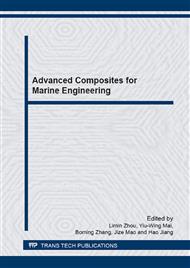[1]
J. R. MacKay, FredvanKeulen, Partial safety factor approach to the design of submarine pressure hulls using nonlinear finite element analysis, Finite ElementsinAnalysisandDesign, 65 (2013) 1-16.
DOI: 10.1016/j.finel.2012.10.009
Google Scholar
[2]
C.C. Lian, C.C. Liao, C.M. Lu, The study of minimum-weight optimal design for submarine pressure hull, in, Institute of Technology, Chung Cheng, (1989).
Google Scholar
[3]
T. Reynolds, O. Lomacky, M. Krenzke, Design and analysis of small submersible pressure hulls Computers & Structures, 3 (1973) 1125-1143.
DOI: 10.1016/0045-7949(73)90042-4
Google Scholar
[4]
C.T.F. Ross, A conceptual design of an underwater vehicle, Ocean Engineering, 33 (2006) 2087–2104.
DOI: 10.1016/j.oceaneng.2005.11.005
Google Scholar
[5]
D. Mills, Submarine design and development, Conway Maritime, London, (1984).
Google Scholar
[6]
C. -C. Liang, H. -W. Chen, C. -Y. Jen, Optimum design of filament-wound multilayersandwich submersible pressure hulls, Ocean Engineering, 30 (2003) 1941–(1967).
DOI: 10.1016/s0029-8018(03)00044-1
Google Scholar
[7]
C. -C. Liang, C. -Y. Hsu, H. -R. Tssi, Minimum weight design of submersible pressure hull under hydrostatic pressure, Compurers and Strucrtures, 63 (1997) 187-201.
DOI: 10.1016/s0045-7949(96)00342-2
Google Scholar
[8]
A. Alvarez, V. Bertram, L. Gualdesi, Hull hydrodynamic optimization of autonomous underwater vehicles operating at snorkeling depth, Ocean Engineering(), 36 (2009) 105-112.
DOI: 10.1016/j.oceaneng.2008.08.006
Google Scholar
[9]
H. Cui, O. Turan, P. Sayer, Learning-based ship design optimization approach, Computer-Aided Design, 44 (2012) 186-195.
DOI: 10.1016/j.cad.2011.06.011
Google Scholar
[10]
C.Y. Jen, Coupled acoustic structural response of optimized ring stiffened hull for scaled down submerged vehicle subject to underwater explosion, Theoretical and Applied Fracture Mechanics, 52 (2009) 96-110.
DOI: 10.1016/j.tafmec.2009.08.006
Google Scholar
[11]
C.Y. Jen, W.H. Lai, Transient response of multiple intersecting spheres of deep-submerged pressure hull subjected to underwater explosion, Theoretical and Applied Fracture Mechanics, 48 (2007) 112-126.
DOI: 10.1016/j.tafmec.2007.05.003
Google Scholar
[12]
C.T.F. Ross, A novel submarine pressure hull design., Journal of Ship Research, 31 (1987) 186-188.
DOI: 10.5957/jsr.1987.31.3.186
Google Scholar
[13]
C.T.F. Ross, A.P.F. Little, The buckling of a corrugated carbon fibre cylinder under external hydrostatic pressure, Ocean Engineering 28 (2001) 1247-1264.
DOI: 10.1016/s0029-8018(00)00039-1
Google Scholar
[14]
C.T.F. Ross, D. Popken, Buckling of Tube-Stiffened Prolate Domes Under External Water Pressure, Thin-Walled Structures, 22 (1995) 159-179.
DOI: 10.1016/0263-8231(94)00034-w
Google Scholar
[15]
C.T.F. Ross, A conceptual design of an underwater missile launcher, Ocean Engineering 32 (2005) 85-99.
DOI: 10.1016/j.oceaneng.2004.04.008
Google Scholar
[16]
C. -C. Liang, S. -W. Shiah, C. -Y. Jen, H. -W. Chen, Optimum design of multiple intersecting spheres deep-submerged pressure hull, Ocean Engineering, 31 (2004) 177-199.
DOI: 10.1016/s0029-8018(03)00120-3
Google Scholar
[17]
J.Y. Zheng, P.F. Liu, Elasto-plastic stress analysis and burst strength evaluation of Al-carbon fiber/epoxy composite cylindrical laminates, Computational Materials Science, 42 (2008) 453-461.
DOI: 10.1016/j.commatsci.2007.09.011
Google Scholar
[18]
A. Inc, ANSYS Theory Reference Release 11. 0, (2007).
Google Scholar
[19]
S. Ma, H. Mahfuz, Finite element simulation of composite ship structures with fluid structure interaction, Ocean Engineering, 52 (2012) 52-59.
DOI: 10.1016/j.oceaneng.2012.06.010
Google Scholar


